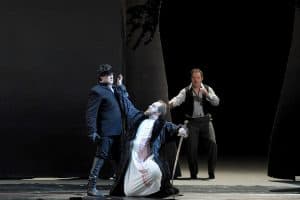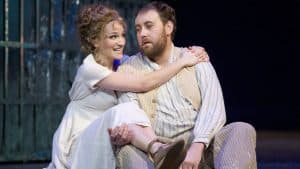What Is Opera Buffa?
Updated February 2023
Da Ponte categorized the libretto of Don Giovanni as a “dramma giocoso,” a common abbreviation for the term “dramma giocoso per musica,” meaning, more or less, “a serious opera with jokes,” sometime including supernatural elements and farce as well. It was a fairly common genre in the middle of the Neapolitan opera style of the 18th century, a hybridized subset of opera buffa. But only three works with that designation are performed regularly today: Rossini’s La Cenerentola, and Mozart’s Don Giovanni and Così fan tutte. And for both of Mozart’s operas, the composer classified them simply as “opera buffa” instead of “dramma giocoso.”
Opera Buffa
The antithesis to opera seria, opera buffa is a comic style of opera developed out of the intermezzi, or interludes, performed between acts of serious operas. Opera buffa is only two acts and focuses on everyday people in contemporary settings dealing with everyday struggles.
Opera Seria
The classic ‘serious’ style of three-act Italian opera popularized in Europe during the 18th century. Characters were usually kings, ancient heroes, and gods and goddesses since performances of opera seria at this time were only for royalty and the ruling classes.
Dramma Giocoso
A term for comic operas with sentimental or pathetic plots bordering on tragedy rather than the traditional lighthearted comic plots that typically end with a dramatic climax.
Opera Buffa, Dramma Giocoso, and ‘Real’ Opera
Are the differences between the two designations significant? Perhaps. As early as 1783, Mozart had been itching to write a “real” Italian opera for Vienna, but with three significant female roles instead of the traditional two; one thoroughly serious, one both serious and comic but equal in vocal and musical quality to the first (a mezzo carattere role, in opera jargon), and one completely buffa. Even though The Marriage of Figaro, didn’t meet these criteria. What’s more, the story of Figaro was French in origin, so it couldn’t really be considered a “true” Italian opera. And in Così there are only two principal female roles. So it seemed that Mozart regarded Don Giovanni as somewhat special and distinct from his other buffa operas—it was the one opera in which he could demonstrate the “true” Italian style to the Viennese. Viennese.
Balancing Farce With Tragedy
Much of this distinction has to do with the balance and placing of the serious elements within the drama. Rather than Don Giovanni being a serious opera “with jokes,” as the common definition of dramma giocoso suggests, it is more like a wholehearted comedy sprinkled with tragic incidents. It is not strictly buffa, only mostly buffa (or at least more buffa than seria). The Commendatore’s death at the opera’s start, for example, or Leporello’s unpleasant task of explaining to Donna Elvira her predicament a little later, are both serious scenes. Still, they are treated with strong comedic touches. (When the Commendatore is killed, for example, Leporello immediately cries out to Figaro, “Is it you or the old guy that died?”) Farce follows directly after the tragedy, rather than the other way around. This creates an inverted narrative in which the audience is not sidetracked by a tragic story by the comedic touches. Rather, they are taken on a comedic journey in which tragedy periodically appears before being instantaneously diverted back into humor. The proportions and placement make all the difference.
The male voice types used in Don Giovanni are also a marker of dramma giocoso style. Although in Mozart’s singspiels such as The Abduction from the Seraglio and The Magic Flute, the tenor role was a heroic role, in Italian opera seria it had been traditional to assign the hero’s role to a castrato. (That was still the case with Mozart’s Idomeneo, from 1781.) Through the 1780s, though, the popularity of the castrati on the opera stage was waning, but the tradition of assigning the serious lead male role to a tenor had not yet replaced it. Mozart re-wrote the castrato role of Idamante in Idomeneo for a tenor when he adapted the opera for Vienna in 1786.
A Hybrid Form of Opera
It’s worth noting that in Mozart’s opera buffas, there are no heroic tenors. In both Figaro and Don Giovanni, both male leads are baritones, while their tenors play secondary roles. In Così, on the other hand, one could argue that there are no heroic male roles in the opera. Looking at what kind of secondary roles the tenors play in these operas makes the distinction between opera buffa and dramma giocoso even clearer. In Figaro, a true opera buffa, the tenor roles are all comic. Still, in Don Giovanni, the tenor is neither comic nor heroic (though Don Ottavio would perhaps like to be heroic!). As a result, it marks Don Giovanni as a hybrid opera form.
The category of dramma giocoso also implies new ways of thinking about the plot, and the roles of high-born and low-born characters. In most opera seria, low-born characters are peripheral to the stories—they act merely as messengers, functionaries, and servants to the royal and aristocratic (or mythological) figures that rule their worlds. In comic opera, on the other hand, from Pergolesi’s La serva padrona and Rousseau’s Le devin du village to Mozart’s Figaro, low-born characters are central to the plot—they drive the story. In contrast, most of the characters in Don Giovanni are aristocratic, and the peasant couple Masetto and Zerlina, and the Don’s servant Leporello are not incidental to the plot. However, in the final sextet (usually cut in the late 18th and 19th centuries), lowborn characters make up half of the ensemble. They join with the three remaining aristocrats in a rebuke of Giovanni’s dissolute ways.
To call Don Giovanni a hybrid does not imply in any way that it was a compromise in quality or musical drama. Quite the opposite—for Mozart, hybridizing was a way of synthesizing the most useful and effective traits from different genres, breaking away from stylized traditions, and producing a new kind of opera in which the drama and music work together even more powerfully than before.
Want to experience the difference between an opera seria and opera buffa for yourself? Explore our wide variety of performances at the Utah Opera!







